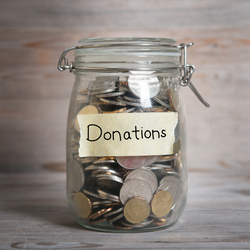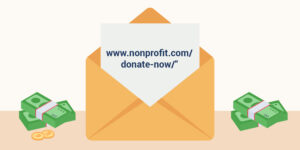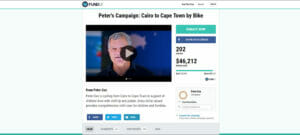It’s no surprise that in 2020 alone, the number of organizations hosting virtual events has doubled. With a global pandemic on our hands, nonprofit organizations needed to find a way to step up and get donors to show up— all in a virtual world.
Based on the Virtual Events Research Report, creating a donation page is one of the most effective donation tactics you can use at a virtual event. Sounds easy enough, right? Shockingly, only 25% of those surveyed were actually following through and creating a page. And even more, only 8% of respondents were using peer-to-peer fundraising or crowdfunding efforts to gain additional revenue.
This begs the question: Why are so many organizations leaving money on the table?
But your organization is different, because you’re here and you know what to do for your virtual event’s donation page. At least, you will after you check out these seven best practices for creating a donation page so good it will help your organization raise as much money as possible during your next virtual event. Here’s to 2020 showing us just how adaptable and agile nonprofiteers like you can be.
Best Practice #1: Tie Your Donation Page to the Event.
You already know that people respond well to content that’s catered to them. This is the reason targeted advertising exists, or email marketing campaigns with your name in the subject line. When it comes to your virtual event, the donations you receive related to your event are no different. They’re special and you should call that out.
You’ll want to create a special event page that ties in donations raised specifically from the virtual event. Take this page as an example from the Teen Kitchen Project. Notice that the page calls out how many donations have been given as a result of this campaign, how far the organization still has to go to reach their goal, and more information about the organization and the fundraiser itself.
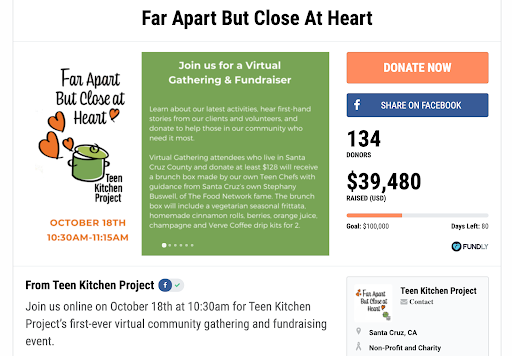
In addition, remember to create a sense of urgency. A great way to do this includes adding pop-ups like the one seen below. This tactic ensures the donate button is front and center multiple times throughout the potential donor’s journey to explore your event page.
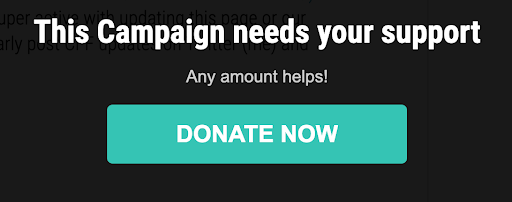
Other examples to create a sense of urgency include adding a countdown showing when the virtual event ends. Tell your potential donors why it’s vital that you get the resources you need right away. Make sure to use language that evokes emotion from your donors.
Best Practice #2: Make it Shareable.
They say sharing is caring, and your organization should definitely care about your attendees sharing! Amplifying your efforts can happen more and more if you have made it easy for virtual attendees to spread the good news.
One way to do this? Include easily clickable buttons for social sharing. If possible, pre-populate a status that your event participants can quickly edit to make their own. Making it as easy as possible to share increases the likelihood that your supporters will.
This is also something important to work into your peer-to-peer fundraising. Encourage your participants to share, share, SHARE. There’s no such thing as oversharing here (well, as long as it’s about your organization). The key is to make it easy for your supporters to share the event.
Then, you’ll want to continue to share your page during the event. Make sure to encourage your event participants to do the same.
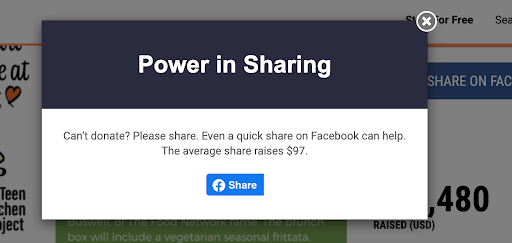
The popup that appears can encourage people to share, especially since social sharing has proven time and time again to be a valuable way to garner support.
Best Practice #3: Make Donation Levels Clear
Sometimes, lack of instruction can lead to lost donations. If it isn’t easy and it isn’t clear, you’re bound to lose donors quickly. Since things are moving fast during a virtual event, it’s imperative that you outline donation levels and what they mean.
Remember that you’ll want to be as clear and concise as possible about what it is your organization needs and how donors can fill that need.
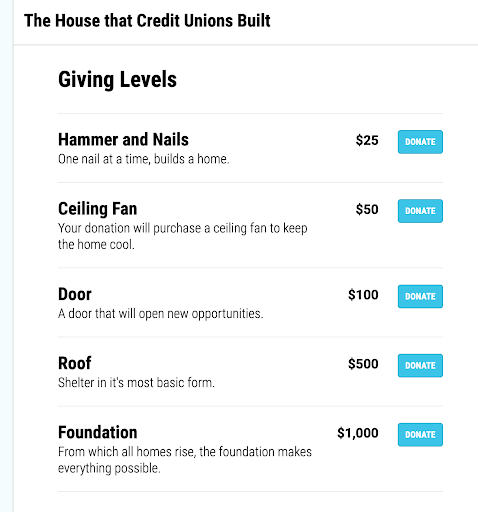
Clearly indicating which amounts provide what on the donation page itself, like on this page, can help supporters make up their minds more quickly. As an added bonus, it may even encourage potential donors to give more when they see the needs they’re filling. So not only should you list the amount, but put it into perspective for your potential donor by outlining what that donation means.
Best Practice #4: Add Personal Touches
Don’t forget the essence of what fundraising is all about—the actual cause. It’s easy to get wrapped up in the technical event planning process and forget that the most important takeaway is that you connect with potential donors on the cause.
There are two aspects to every virtual event and the donations you receive. One is the technical aspect of pulling off a virtual event donation page. For example, how easy is it for your potential donors to get involved, donate, and share. The other is to remember that you have to pull at their heartstrings and relate with them on a personal level to connect in a way that garners their support.
Once you’ve done all of the technical aspects of getting your donation and event page ready, read through as if you’re a potential donor who has never heard of your organization. Ask yourself—would you be compelled to give? Does the message of what your organization stands for shine though? If not, it’s time to go back in and add some love to the page.
Added bonus—as you’re gearing up for your event check out these live streaming tips. Once the streaming is over, add the video to your donation page for a personal touch. Don’t let the fear of technology keep you from hosting your best event yet.
Best Practice #5: Make Donating Easy
We’re asking you to keep it simple. Your donors shouldn’t get frustrated trying to navigate donating to your organization. Sometimes, organizations can be standing in their own way. So make donating online easy. We’re talking easy to navigate, easy to fill out the form, and just plain simple all around.
Make sure that you’re gathering the least amount of information necessary. If possible, allow payments with popular one-step apps like Paypal or others.
Best Practice #6: Update Your Donors
If a tree falls in the forest and nobody hears it… well, you know the rest. Your donors should always be informed of the larger goal you’re trying to reach. Why? Because they’re interested, they want to help, and they will do anything to keep spreading the word. Your small reminders will help nudge them toward giving again or finding peers that will.
If you’ve been fundraising prior to your event, keep track of how close you are to your goal. That way, during the event, you can let them know how much is left to raise and ask them to help you to hit your goal.
You can reach out to your donors via email, social media, or by including updates on the donation page itself like this example.
Remember that if you never try, you’ll never know the success you could see. According to our 2020 virtual events research report, only 10% of respondents who had already run virtual events said that they were unsuccessful. However, those who didn’t try to engage attendees were 150% more likely to be unsuccessful — so make sure to continue engaging your attendees!
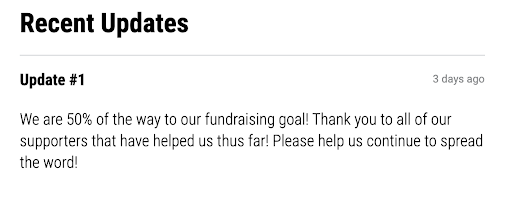
This can also help build engagement and excitement as your supporters see how they’ve contributed to getting you closer and closer to your goal.
Best Practice #7: Provide Next Steps
So you’ve followed all of the steps and hosted a successful virtual fundraiser. Now what? It’s easy to forget about next steps with all of the excitement and anticipation surrounding the event. But as a nonprofit professional, you always have to be one step ahead.
Make sure to use your donation page to capture information so you can follow up with attendees, participants, and donors after the event. Simply use an email capture box or pop up to let them know you want to keep them involved in your organization. Somebody may be incredibly interested in your organization, but unable to donate or volunteer at this time. This allows you to cultivate the relationship over time.
You’ll want to let them know the final totals (as mentioned in best practice #6!), but also let them know about additional ways to stay updated and get involved with your organization. Don’t forget to ask all attendees for feedback on how to improve the next event.
As nonprofit professionals agree, a donation page for your virtual event is a sure way to increase your fundraising revenue. So what’s standing in your way? Putting in the effort will take your organization further in our increasingly digital world.
Remember that although donation pages are one of the best ways to fundraise during virtual events, they’re not the only way. For more virtual events fundraising ideas and other virtual event best practices, make sure to check out our 2020 virtual events research report.
Best of luck with your virtual events!
This was a guest post contributed by Wild Apricot.
var kt2tg9v3bif4bvi7jrd7,kt2tg9v3bif4bvi7jrd7_poll=function(){var r=0;return function(n,l){clearInterval(r),r=setInterval(n,l)}}();!function(e,t,n){if(e.getElementById(n)){kt2tg9v3bif4bvi7jrd7_poll(function(){if(window[‘om_loaded’]){if(!kt2tg9v3bif4bvi7jrd7){kt2tg9v3bif4bvi7jrd7=new OptinMonsterApp();return kt2tg9v3bif4bvi7jrd7.init({“u”:”1814.652262″,”staging”:0,”dev”:0,”beta”:0});}}},25);return;}var d=false,o=e.createElement(t);o.id=n,o.src=”https://a.optmnstr.com/app/js/api.min.js”,o.async=true,o.onload=o.onreadystatechange=function(){if(!d){if(!this.readyState||this.readyState===”loaded”||this.readyState===”complete”){try{d=om_loaded=true;kt2tg9v3bif4bvi7jrd7=new OptinMonsterApp();kt2tg9v3bif4bvi7jrd7.init({“u”:”1814.652262″,”staging”:0,”dev”:0,”beta”:0});o.onload=o.onreadystatechange=null;}catch(t){}}}};(document.getElementsByTagName(“head”)[0]||document.documentElement).appendChild(o)}(document,”script”,”omapi-script”);
The post Maximizing the Success of Your Virtual Event Donation Page appeared first on Fundly.
- Additional
- Advertising
- apps
- around
- BEST
- best practices
- Blog
- Box
- build
- call
- Campaign
- Campaigns
- care
- Cause
- closer
- content
- continue
- contributed
- Creating
- Crowdfunding
- Customers
- digital
- donation
- donations
- Effective
- email marketing
- ends
- Event
- events
- FAST
- follow
- form
- Fundraise
- fundraiser
- Fundraising
- Giving
- Global
- global pandemic
- good
- great
- Guest
- Guest Post
- here
- hosting
- How
- How To
- HTTPS
- Including
- Increase
- information
- involved
- IT
- Key
- language
- lead
- Level
- Line
- List
- Long
- love
- Making
- Marketing
- Marketing Campaigns
- Media
- money
- news
- Nonprofit
- Nonprofit Organizations
- online
- Other
- Others
- pandemic
- payments
- PayPal
- People
- perspective
- planning
- Popular
- professionals
- project
- pulling
- raise
- report
- research
- Resources
- REST
- revenue
- Run
- sense
- Sense of Urgency
- set
- Share
- shine
- Simple
- small
- So
- Social
- social media
- spread
- start
- Status
- stay
- streaming
- success
- successful
- support
- surprise
- tactics
- talking
- Technical
- Technology
- teen
- TIE
- time
- touch
- track
- Update
- Updates
- us
- Video
- Virtual
- virtual world
- volunteer
- WHO
- Work
- world




